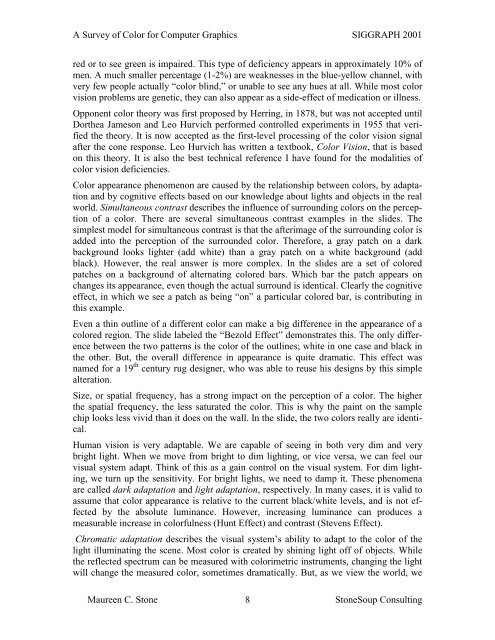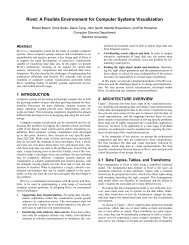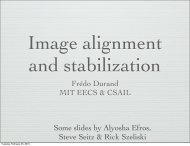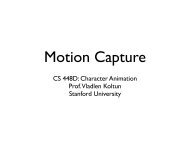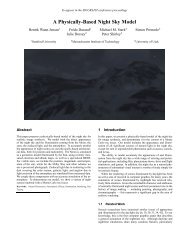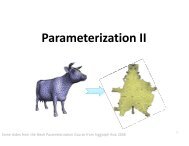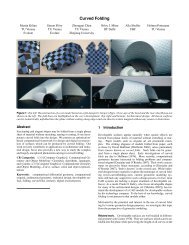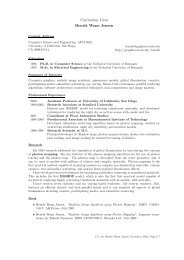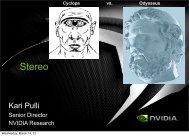A Survey of Color for Computer Graphics
A Survey of Color for Computer Graphics
A Survey of Color for Computer Graphics
Create successful ePaper yourself
Turn your PDF publications into a flip-book with our unique Google optimized e-Paper software.
A <strong>Survey</strong> <strong>of</strong> <strong>Color</strong> <strong>for</strong> <strong>Computer</strong> <strong>Graphics</strong> SIGGRAPH 2001<br />
red or to see green is impaired. This type <strong>of</strong> deficiency appears in approximately 10% <strong>of</strong><br />
men. A much smaller percentage (1-2%) are weaknesses in the blue-yellow channel, with<br />
very few people actually “color blind,” or unable to see any hues at all. While most color<br />
vision problems are genetic, they can also appear as a side-effect <strong>of</strong> medication or illness.<br />
Opponent color theory was first proposed by Herring, in 1878, but was not accepted until<br />
Dorthea Jameson and Leo Hurvich per<strong>for</strong>med controlled experiments in 1955 that verified<br />
the theory. It is now accepted as the first-level processing <strong>of</strong> the color vision signal<br />
after the cone response. Leo Hurvich has written a textbook, <strong>Color</strong> Vision, that is based<br />
on this theory. It is also the best technical reference I have found <strong>for</strong> the modalities <strong>of</strong><br />
color vision deficiencies.<br />
<strong>Color</strong> appearance phenomenon are caused by the relationship between colors, by adaptation<br />
and by cognitive effects based on our knowledge about lights and objects in the real<br />
world. Simultaneous contrast describes the influence <strong>of</strong> surrounding colors on the perception<br />
<strong>of</strong> a color. There are several simultaneous contrast examples in the slides. The<br />
simplest model <strong>for</strong> simultaneous contrast is that the afterimage <strong>of</strong> the surrounding color is<br />
added into the perception <strong>of</strong> the surrounded color. There<strong>for</strong>e, a gray patch on a dark<br />
background looks lighter (add white) than a gray patch on a white background (add<br />
black). However, the real answer is more complex. In the slides are a set <strong>of</strong> colored<br />
patches on a background <strong>of</strong> alternating colored bars. Which bar the patch appears on<br />
changes its appearance, even though the actual surround is identical. Clearly the cognitive<br />
effect, in which we see a patch as being “on” a particular colored bar, is contributing in<br />
this example.<br />
Even a thin outline <strong>of</strong> a different color can make a big difference in the appearance <strong>of</strong> a<br />
colored region. The slide labeled the “Bezold Effect” demonstrates this. The only difference<br />
between the two patterns is the color <strong>of</strong> the outlines; white in one case and black in<br />
the other. But, the overall difference in appearance is quite dramatic. This effect was<br />
named <strong>for</strong> a 19 th century rug designer, who was able to reuse his designs by this simple<br />
alteration.<br />
Size, or spatial frequency, has a strong impact on the perception <strong>of</strong> a color. The higher<br />
the spatial frequency, the less saturated the color. This is why the paint on the sample<br />
chip looks less vivid than it does on the wall. In the slide, the two colors really are identical.<br />
Human vision is very adaptable. We are capable <strong>of</strong> seeing in both very dim and very<br />
bright light. When we move from bright to dim lighting, or vice versa, we can feel our<br />
visual system adapt. Think <strong>of</strong> this as a gain control on the visual system. For dim lighting,<br />
we turn up the sensitivity. For bright lights, we need to damp it. These phenomena<br />
are called dark adaptation and light adaptation, respectively. In many cases, it is valid to<br />
assume that color appearance is relative to the current black/white levels, and is not effected<br />
by the absolute luminance. However, increasing luminance can produces a<br />
measurable increase in colorfulness (Hunt Effect) and contrast (Stevens Effect).<br />
Chromatic adaptation describes the visual system’s ability to adapt to the color <strong>of</strong> the<br />
light illuminating the scene. Most color is created by shining light <strong>of</strong>f <strong>of</strong> objects. While<br />
the reflected spectrum can be measured with colorimetric instruments, changing the light<br />
will change the measured color, sometimes dramatically. But, as we view the world, we<br />
Maureen C. Stone 8<br />
StoneSoup Consulting


